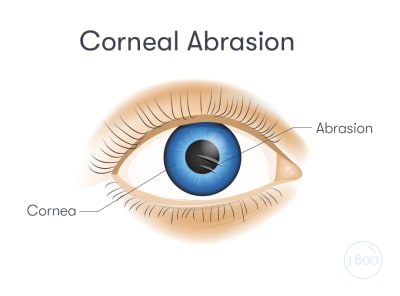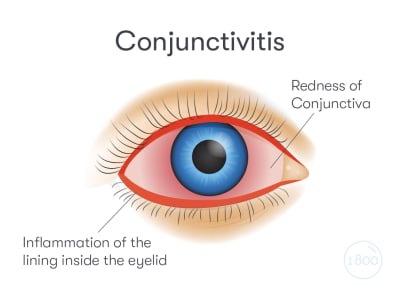Contact lens problems to watch out for
If you’ve worn contact lenses before, you know how truly wonderful they can be. You’re also likely to be familiar with what happens when a contact lens is having a bad day. Sometimes your eyes and contacts just don’t mix. That’s okay, everything needs a break every once in awhile.
But there’s a difference between regular, “my eyes need a day off”, discomfort and true pain. Unfortunately, that line can be blurry at times.
So, how can you tell the difference? How does mild discomfort turn into a trip to the eye doctor?
How contacts are supposed to fit
When working effectively, your contact lenses should be comfortable, moist and wearable for eighteen hours or more. In fact, if they are an especially good fit and a fresh pair, you might even forget you’re wearing them after a while.
If your contacts are causing you discomfort or irritation, there are a few possible reasons why.
If you’re healthy and your lenses are new, it’s possible the lens itself is defective. Mistakes during manufacturing can happen and it’s not incredibly uncommon. Luckily, this is a simple fix. Just toss that lens and get a new one.
In some cases, a new lens can be uncomfortable because it doesn’t fit properly. Lenses can be too tight, too loose or too thick. The main symptoms of poor fitting contacts are redness, discomfort, blurred vision, and itchiness.
Fit isn’t the only common cause of discomfort though. They can also have unintentionally sharp edges or the prescription itself can be wrong. Should these kinds of complications arise, be sure to see your eye doctor as soon as possible.
Luckily, we’ve got your back with our Gajillion Percent Promise. If you have any issues with your contacts, like poor fit or a defective lens, just let us know. We’ll always help you replace, return, or exchange your contacts at no extra cost.
Potentially serious problems
Most complaints like lens discomfort or irritation are minor and easy to fix. Unfortunately, there are complications related to wearing contacts that can lead to serious health issues.
If you experience any of the following symptoms, we’d recommend consulting your eye doctor: severe eye pain, consistent irritation, light sensitivity, redness, discharge, swelling, or blurred vision.
Don’t panic. This doesn’t necessarily mean something serious is wrong, but it’s best to double check.
Corneal Abrasion
A corneal abrasion is a common problem that can happen when abrasive particles get trapped underneath a contact lens, causing scratches or nicks to the cornea. This is most frequent with RGP and hard lenses.
Corneal abrasions can also occur from wearing lenses that were incorrectly manufactured leading to rough or sharp edges. If you have eye pain that persists for more than a day, you’ll want to consult with your eye doctor. Severe corneal abrasions that are not treated may lead to a vision-threatening corneal ulcer.
Yikes.

Dry Eye Syndrome
Dry eye syndrome is another common issue where contact lens wear causes your eyes to not produce enough tears to keep your eyes lubricated. Dehydration can lead to lens discomfort, a lack of oxygen transmission, and an increased risk of infection.
Dry eyes can be caused by several things like increased alcohol consumption, oral contraceptives and dry, windy weather. If the problem persists, cut down on your lens wearing time, and use eye drops.
Be sure to consult your eye doctor if you experience any new symptoms.
Conjunctivitis
Conjunctivitis is an infection or inflammation of the lining inside the eyelid connected to the sclera. It’s usually caused by lenses that are not kept clean or properly disinfected. It can also be the result of inserting lenses before washing your hands.
Symptoms of conjunctivitis include redness, a burning sensation, and sticky discharge from your eye. If you experience any discharge, you’ll want to stop wearing lenses immediately. In most situations, a warm compress and time will clear up conjunctivitis.
In some cases, you may need medical attention if symptoms persist or worsen.

Keratitis
Simply put, Keratitis is an infection of the cornea. It causes inflammation and can have complications leading to permanent vision loss. The most common side effects of keratitis are pain and light sensitivity.
Keratitis is common in soft lenses that are not properly cleaned and disinfected, or lenses that have been rinsed with contaminated water. The infection always requires medical attention and may need emergency care in severe situations. Not good at all.

Corneal Edema
A corneal edema is a swelling of the cornea caused by a lack of oxygen. It’s often the result of improperly using extended wear contact lenses. Symptoms of a corneal edema include hazy vision, halos around lights, and mild pain when removing your lenses.
Seeing halos around lights at night with contacts isn’t uncommon and shouldn’t be interpreted as medical emergency. These halos occur when the pupil is dilated to a larger size than the optical area of a contact lens. Seeing rainbows around lights with contact lenses, however, can be a sign of corneal swelling. It’s an indication that your lenses have been worn for too long and should be taken out.
In the case of a corneal edema, taking out your lenses or switching to disposable dailies can alleviate symptoms. Without proper attention, a corneal edema can cause infection or permanent scarring.
Blurred vision
Blurred vision in one or both eyes is a more serious condition. Obviously, the occasional blurriness from a shifted lens or stray particle is nothing to get concerned over. It becomes a serious matter when it appears without a clear cause and lasts longer than a few minutes.
This is especially true if the blurriness appears to be worsening as time passes. Unfortunately, this kind of vision loss is a medical emergency as there could be several serious underlying conditions at work.
You’ll want to consult with a medical professional as soon as possible to avoid any long-lasting damage to your vision.
Blepharitis
Blepharitis is a backup of the oil glands on lid margins, often accompanied by the overgrowth of skin bacteria around the eyelashes. A lack of oil in tears produces poor quality tears, leading to dry eye, lens discomfort and a deposit buildup.
A warm compress used daily and a gentle side-to-side scrubbing of the eyelashes with a warm washcloth can alleviate symptoms. If the condition continues, be sure to talk to your eye doctor.

We’ll say it again – consult your eye doctor
If you have any concerns about your eye health or are experiencing persistent symptoms like redness or irritation, we’ll always recommend consulting your eye doctor. It’s likely there’s an environmental factor impacting your vision or simply a misfitted contact lens, but either way it’s always a good idea to double check.
Original published date: 1/24/2020
Updated: 10/31/2022





